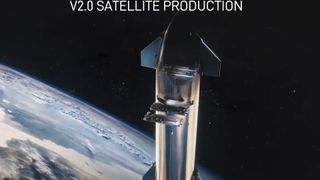
SpaceX's Starship vehicle will operate like a gigantic flying Pez dispenser on some missions, if all goes according to plan.
When it comes online, Starship will be the biggest and most powerful space transportation system ever built. SpaceX is developing the vehicle to take people and cargo to the moon and Mars and to perform a variety of other spaceflight tasks — including deploying the next-gen version of its Starlink internet satellites.
Current Starlink spacecraft are launched by SpaceX's workhorse Falcon 9 rocket. But Starlink 2.0 satellites will be much more capable and much bigger, each of them tipping the scales at about 1.25 tons (1,130 kilograms) here on Earth, compared to about 660 pounds (300 kg) for current Starlink craft.
Photos: SpaceX lifts huge Super Heavy rocket onto launch stand
That's too hefty for the Falcon 9 to handle, at least in the big batches that SpaceX likes to loft. (Each Falcon 9 mission has historically launched 50 to 60 Starlink satellites.)
Starship "is the only thing that can carry the Starlink 2 satellites," SpaceX founder and CEO Elon Musk said in a recent interview with Everyday Astronaut's Tim Dodd.
"Falcon has neither the volume nor the mass-to-orbit capability required for Starlink 2," Musk added, presumably referring to both the Falcon 9 and its brawnier cousin, the Falcon Heavy.
Get the Space.com Newsletter
Breaking space news, the latest updates on rocket launches, skywatching events and more!
And we already know how Starship will deploy those big Starlink 2 satellites in Earth orbit, thanks to a video deck from a presentation that Musk gave to SpaceX employees last week. The 2-minute deck, which Musk posted on Twitter yesterday (June 5), shows Starlinks popping through a slim slot near the top of the Starship spacecraft. (Starship will consist of two reusable elements: a huge first-stage booster called Super Heavy and an upper-stage spacecraft called Starship.)
In the animation, Starship looks very much like a huge, shiny Pez dispenser, as one of Musk's Twitter followers pointed out. And the billionaire entrepreneur seems very much onboard with the comparison.
"Maybe we should make an actual Starship model that dispenses pez for our merch store," he tweeted yesterday.
SpaceX is gearing up for a huge moment in Starship's development — the system's first orbital test flight, which the company aims to conduct in the next few months from Starbase, its facility in South Texas. That launch cannot happen, however, until the U.S. Federal Aviation Administration (FAA) wraps up an environmental review of Starbase.
That review was originally expected to be done by the end of 2021, but the FAA has pushed back its completion date multiple times. The current deadline is June 13.
Mike Wall is the author of "Out There" (Grand Central Publishing, 2018; illustrated by Karl Tate), a book about the search for alien life. Follow him on Twitter @michaeldwall. Follow us on Twitter @Spacedotcom or on Facebook.
Join our Space Forums to keep talking space on the latest missions, night sky and more! And if you have a news tip, correction or comment, let us know at: community@space.com.

Michael Wall is a Senior Space Writer with Space.com and joined the team in 2010. He primarily covers exoplanets, spaceflight and military space, but has been known to dabble in the space art beat. His book about the search for alien life, "Out There," was published on Nov. 13, 2018. Before becoming a science writer, Michael worked as a herpetologist and wildlife biologist. He has a Ph.D. in evolutionary biology from the University of Sydney, Australia, a bachelor's degree from the University of Arizona, and a graduate certificate in science writing from the University of California, Santa Cruz. To find out what his latest project is, you can follow Michael on Twitter.
Most Popular

